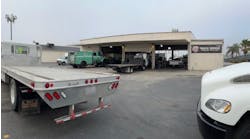This is Part Two of a two-part story. Click here to read Part One.
Fleets and service providers have several factors to keep in mind when choosing the best distributors for the tools and shop equipment they need. While pricing is obviously important, things like communication, speed, selection, and customer service may have an even bigger impact on your operation.
All of these factors can impact uptime, and therefore your revenue, so we put together some best practices to help you choose the right distributor for the fleet’s various needs.
Tools and shop equipment
In the intricate world of fleet maintenance and repair operations, the selection of diagnostic tools and shop equipment plays a pivotal role in ensuring optimal fleet health and operational efficiency. Tool suppliers should be able to provide solutions that enhance the not just the repair, but the overall maintenance operation.
“Advanced diagnostic tools with cutting-edge technology can perform everything from dealer-level functions to triage and monitoring,” Johnson said. “Precise diagnostics enable informed decision-making and strategic planning. By recognizing patterns in reporting from diagnostic tools, fleet managers and service providers should be able to identify trends and improve efficiency and safety across the board.
“Repair software should have troubleshooting, step-by-step instructions, color-coded wiring diagrams, schematics, manuals, and more,” Johnson continued. “Hardware should offer reliable connectivity and compatibility with a wide range of vehicles. Dealer-level diagnostic tools, for example, come with the ability to refresh hardware over time, in some cases at no cost.”
For shop equipment, Harris said, ensure you have the proper tools required to do the job, including maintenance software from major component manufacturers.
For Balkonis, tools and shop equipment that provide access to and an understanding of diagnostic and service information for the vehicles fleets and service providers are maintaining is crucial. “For example, it should identify all the special tools and equipment needed to successfully maintain and/or repair vehicles,” he explained further.
“In some cases, a repair cannot be made without leveraging some of these special service tools,” Balkonis added. “That is why it is important to consult your dealer to determine if their expertise is needed to complete a service event or repair.”
Parts and lubricants
A broad selection of parts ensures you can find the exact part you need, noted Kevin Lydic, VP of business development, FinditParts. “The parts search can be exhausting when you have to go to multiple sources,” he said. “Understanding how a particular supplier labels parts availability is also important. Sometimes it might appear as if an online retailer might have the part available but in reality, they don’t. In all, this causes wasted time and is largely inefficient.
“Choose suppliers with extensive inventories that cover a wide range of parts and are likely to have rare or hard-to-find items,” Lydic continued. “That will save you a lot of time. Also ensure they have live inventory feeds with accurate stocking information.”
Lydic also advised fleets and service providers to evaluate parts suppliers for fair pricing and for offering loyalty programs. “Remember, price isn’t everything,” he said. “There is the cost of doing business, too. Do they have a good return policy? What about core returns? Do they have a dedicated support team? All these factors ultimately add up in the final price of that item. Ensure you are working with suppliers who will offer good terms.”
Having access to a wide variety of parts from a single source can greatly simplify the procurement process, Lydic added. It reduces the time and effort spent searching for parts across multiple suppliers and can lead to better pricing and consistency in quality.
For parts, noted Harris, the closer fleets and service providers can get to OEM specifications, the better.
Utilizing online tools allows fleets and service providers the option to search a part number, confirm inventory and availability, and make informed buying decisions with their local dealer, Balkonis noted.
“There are two sources for customers to select parts based on their needs,” said Williamson. “They can call any of our dealer locations where part experts can assist with finding the best part to fit their needs. They can also search, find, and buy any parts online. Once they have found the part they need, they can visit a dealer to pick it up or the dealer will deliver it to their facility.”
Centnarowicz pointed out that leveraging online tools can eliminate the guesswork from picking the right product online. “Using online comparison tools can also help find the right product to get the best results from your project,” he said.
“Suppliers that offer a wide variety of products make it easier to source all your needs from one place,” said Johnson. “That streamlines procurement processes and reduces administrative overhead.”
Communication and speed of delivery
Effective communication and support can significantly enhance the purchasing experience.
“Nothing is worse than a poor experience with a parts supplier, especially when you have a big order on the line,” said Seewack. “Look for suppliers with knowledgeable support teams that are accessible through multiple channels and can assist with technical inquiries and order issues.
“Technological integration is important as well,” Seewack continued. “For example, streamlined ordering systems save time and reduce errors, so opt for suppliers who offer advanced online systems that facilitate easy searching, ordering, and tracking capabilities.
“Clear and prompt communication from suppliers ensures that fleets and service providers are well-informed about product availability, order status, and delivery schedules,” Seewack added. “That also helps quickly resolve any issues that may arise, enhancing trust and reliability.
Amy Morel, director, dealer enablement, Navistar, said solutions provided to fleets and service providers through dealers means parts are available in their area or can be sourced quickly. “We focus on establishing trusted relationships with fleets and service providers to help them navigate the parts support they need,” she stated. “Dealers can serve as advisors, assisting in deciding what maintenance and repair parts are most appropriate for their operation.”
Communication is critical, especially for parts availability and OEM options, noted Harris. “The speed of delivery allows providers to stock less parts and work within a just-in-time model,” he said. “Communication and variety of products also help promote uptime to keep vehicles on the road.”
“The speed of the repair can be a major factor in reducing downtime,” said Lydic. “Nothing is better than being able to go down the road to get the part you need, but when the part isn’t available in a local inventory, you’ll need a trusted supplier who can offer fast, reliable delivery options. Suppliers who can offer rapid delivery options, including same-day or next-day service, can be crucial in situations where a vehicle needs urgent repairs.”
When a truck is down, Centnarowicz noted, communication, speed of delivery, and variety of products are critical to getting things back up and running. “You need to be able to find the right product, at the right price, delivered to you right away,” he said. “A supplier with a large assortment of tools, parts, and supplies and who can offer same-day shipping on most orders can help keep your business running.”
Choose suppliers that offer fast and reliable shipping options to keep your fleet running smoothly, said Johnson. “Effective communication with suppliers is also crucial for smooth transactions,” he added. “Clear and timely communication ensures that orders are processed accurately and issues are addressed promptly.
“Parts and tool suppliers who offer excellent customer service in the form of responsive and knowledgeable support teams can help address issues quickly and minimize downtime,” Johnson continued. “With a commitment to quality, reliability, and customer satisfaction, parts suppliers can be trusted partners in fleet maintenance and repair operations.”





